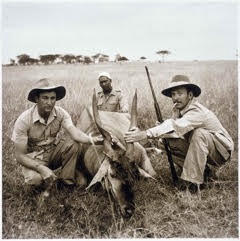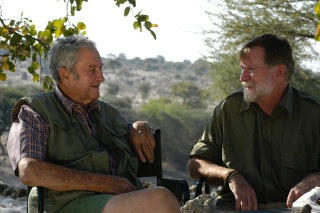
Harry Selby (left) and Robert Ruark on Ruark’s first safari in 1952, which resulted in Ruark writing Horn of the Hunter, the most widely read book about safari hunting that has ever been published. Ruark with his East African eland that he collected on the plains of northern Tanganyika.

In June 2007, in a safari camp in Botswana, Harry Selby (left) and Joe Coogan discuss the many safaris they did together over the years.
|
John Henry (Harry) Selby, 92, died peacefully in the early hours of January 20, 2018 at his home in Maun following a year of declining health.“Harry Selby… is the most man I ever met… a man who can combine gentleness with toughness, bravery with timidity, recklessness with caution, sophistication with naïveté, kindness with harshness, mechanics with poetry, adult judgment with juvenile foolishness. And all the while, making every woman he meets want to mother him or marry him, and every man he meets respect him.”
This is how, in a Reader’s Digest article from August 1954, entitled The Most Unforgettable Character I’ve Met, Robert Ruark introduced Harry Selby to the readers. Two years before that, in 1952, Ruark and his wife, Virginia, spent six weeks in the Tanganyika (now called Tanzania) bush on safari with Harry, who so impressed Ruark that he wrote a book about it called Horn of the Hunter. The book became the most widely read book about safari hunting that has ever been written. It described Ruark’s safari experiences and largely featured Harry, who soon became an established and recognized name in safari circles throughout the world.
Born John Henry Selby on July 22, 1925 in South Africa, Harry was the youngest of six children born to Arthur and Evelyn Selby. Shortly after World War I, many settler farmers and ranchers left South Africa seeking affordable land on which to raise cattle. The British government was offering land in Kenya to all British subjects who had served with the British forces during WW I. In 1928, Harry’s father, encouraged by reports from relatives who had already made the trip to East Africa, packed up his family and all their worldly belongings and moved to Kenya. The family eventually acquired 40,000 acres in the Laikipia district. There, in the shadow of Mount Kenya, the Selby family built their homestead overlooking game-filled plains.
During the war years, Harry spent much of his extra time hunting with native trackers to supply meat for the British wartime effort. In 1945, following the end of WWII, Selby gained a well-earned spot among an elite group of men under the watchful eye and blessings of the great Philip Percival, who had been part of the Roosevelt safari in 1909 and, later, guided Ernest Hemingway on his Green Hills of Africa safari. Harry joined a whole new crop of professional hunters who were then still known as “white hunters.” He was not yet 20 years old when he received his first professional hunter’s license and, by the age of 25, Harry’s reputation was well established. During the next several decades, a steady stream of safari clientele often had to book five years in advance in order to have a chance of hunting with Harry. His memories of the events of a life spent afield were the trophies that he savored the most.
The job of a professional hunter in those days was vastly different from what it is today. When a safari rolled out of Nairobi bound for the bush, it was like a ship setting out on an ocean voyage, complete with crew and fully self-contained. Safari transportation typically consisted of a five-ton truck that carried the crew, camp equipment, provisions, fuel and water, and one hunting car. The professional hunter, like the captain of a ship, embodied many skills to provide a safe and enjoyable experience for his clients. Harry was a master at running an efficient and comfortable safari camp and never failed to keep his clients happy, including royalty, presidents and heads of state, not to mention known and recognized celebrities, film stars and captains of industry. Harry enjoyed an illustrious and eventful career that spanned more than five decades.
Harry was a man of great confidence and capability, possessing a world of knowledge about the bush and the game that lived there. During his 50+-year career, he enjoyed all types of hunting. Big ivory certainly held a special attraction for him and he considered leopard to be one of the most exciting hunts, and most challenging. But for really chilling stuff, he felt nothing could compare to tracking a lion on foot into thick bush. But what Harry really enjoyed doing was to stalk after a herd of buffalo and be completely surrounded by them in thick cover—that’s when his senses were at their sharpest and he felt completely alive. Harry considered this to be the greatest feeling that big game hunting can provide.
During his life, Harry was quick to embrace the latest technologies of the modern world from motorcars to firearms and, most particularly in his later years, he adapted to the computer age. He stayed busy writing his memoirs, magazine articles and scanned his many thousands of photographs to digital format. His computer allowed him a way to keep up with an array of people who were once among his safari clients, but had become lifelong friends from around the world.
Harry is survived by Miki, his wife of 65 years, and his daughter, Gail, both of whom who live in Maun, and three grandchildren that includes Reginah, Serena and Michael. His son, Mark, passed away in 2017.
On an extradordinarily good day on safari, Harry was often known to exclaim, “Jolly good show!” Just the same could be said of his life where he held Africa and her people in his highest regard and possessed the greatest respect for the animals he spent his life among.
— Joe Coogan